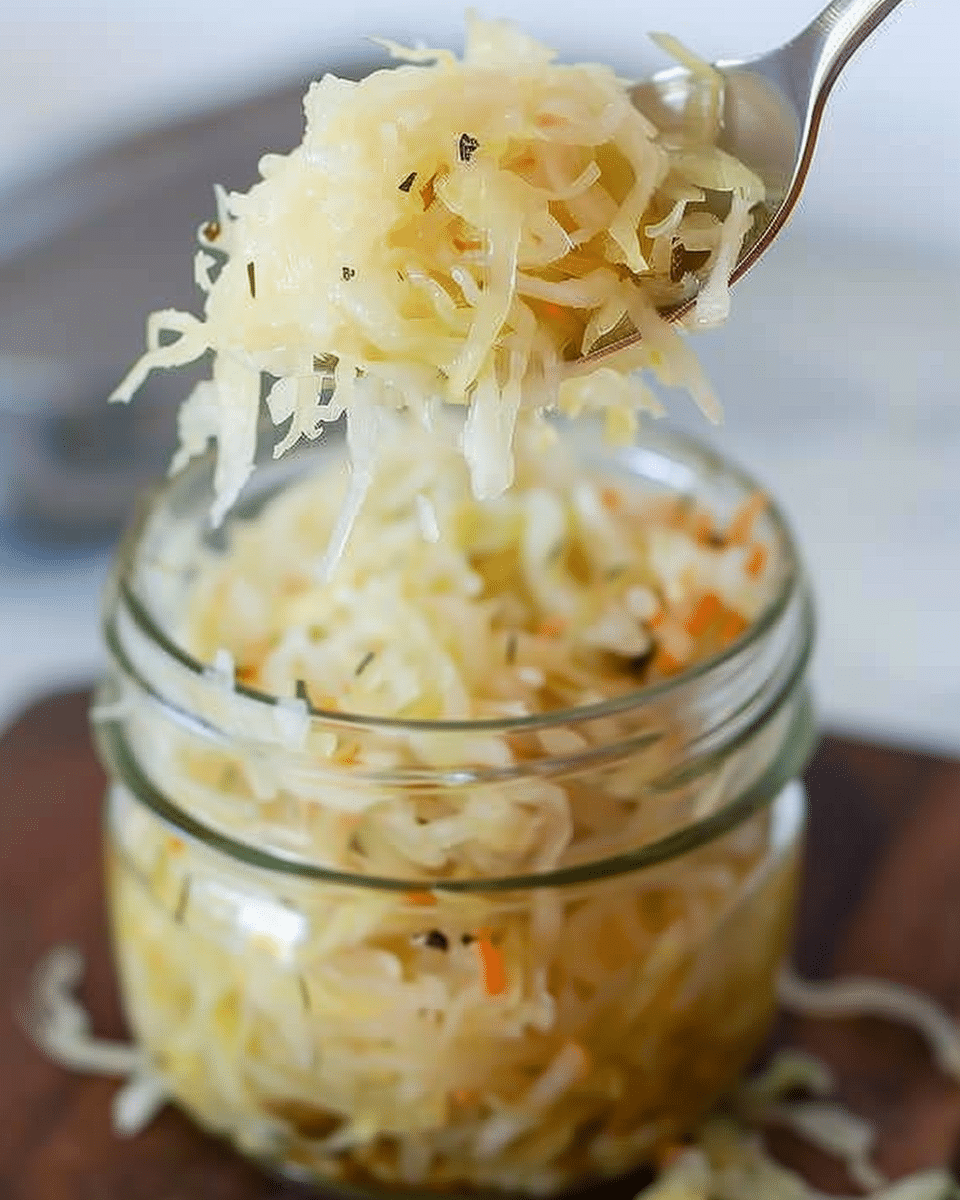Why You’ll Love This Recipe
This homemade keto sauerkraut is not only delicious but also nutritious. It’s packed with probiotics that can help improve digestion and boost gut health. Plus, it’s low in carbs and naturally gluten-free, making it perfect for keto, paleo, and other low-carb diets. The simple process of fermentation allows you to make a large batch and store it for weeks, providing a cost-effective and healthy homemade snack.
ingredients
(Tip: You’ll find the full list of ingredients and measurements in the recipe card below.)
- 1 medium cabbage head
- 1 small carrot, grated
- 1 small onion, shredded
- 3 bay leaves
- 10 whole black peppercorns
- 1/4 tsp cumin
- 1 tbsp salt
directions
1. Prepare the Cabbage:
Cut the cabbage in half and remove the hard core. Then, using a cabbage shredder or knife, slice the cabbage into thin strips. Place the shredded cabbage into a large bowl.
2. Add the Other Ingredients:
To the bowl, add the grated carrot, shredded onion, bay leaves, black pepper, cumin, and salt.
3. Mix and Squeeze:
Using your hands, mix everything thoroughly. Press and squeeze the cabbage as you mix to help release its natural juice. This is the brine that will help in the fermentation process.
4. Pack into a Jar:
Transfer the cabbage mixture into a clean jar, along with the juice. Press the cabbage down firmly to ensure it’s submerged in the brine. Leave a little space at the top to allow for expansion during fermentation.
5. Cover and Ferment:
Cover the jar with cheesecloth or a clean kitchen towel. Leave it at room temperature for about 3 days to allow the fermentation process to begin.
6. Refrigerate:
After 3 days, transfer the jar to the refrigerator and let it sit for at least 2 more days. The longer it sits, the more flavorful it becomes.
7. Serve:
After the resting period, your homemade keto sauerkraut is ready to be served! Enjoy it as a side dish, on top of meats, or as a healthy snack.
Servings and timing
This recipe makes approximately 5 servings.
Prep Time: 10 minutes
Resting Time: 5 days
Total Time: 5 days 10 minutes
Variations
- Add Herbs and Spices: Customize the flavor by adding other herbs or spices such as dill, mustard seeds, or garlic.
- Add Chili for Heat: For a spicy kick, add some red pepper flakes or chopped fresh chili peppers.
- Ferment Longer: Let the sauerkraut ferment for a longer period (up to 7 days) for a more robust flavor.
storage/reheating
Store the sauerkraut in the refrigerator, where it will keep for several weeks. It should be stored in an airtight container to preserve its flavor and freshness. There’s no need to reheat it; it’s best enjoyed chilled, but it can also be added to hot dishes if you prefer.
FAQs
Can I use a different type of cabbage?
Yes, while green cabbage is most commonly used, you can also try purple cabbage for a different color and slightly sweeter flavor.
Do I need special equipment to make this sauerkraut?
No special equipment is required other than a clean jar or container for fermentation. You can use a large glass jar or a fermentation crock.
What can I do if the cabbage isn’t fully submerged in the brine?
You can use a clean weight (such as a small jar or a fermentation weight) to keep the cabbage submerged. This will help prevent mold from forming during fermentation.
Can I make sauerkraut without the carrot and onion?
Yes! The carrot and onion add flavor and a bit of sweetness, but you can skip them and make a more traditional, simple sauerkraut with just cabbage, salt, and spices.
How can I tell if my sauerkraut is ready?
The sauerkraut will develop a tangy, fermented flavor the longer it ferments. Taste it after a few days, and if it’s reached the flavor you prefer, move it to the refrigerator.
Conclusion
Homemade keto sauerkraut is an easy, flavorful, and healthy dish that’s a great addition to any low-carb or ketogenic diet. By using simple ingredients and a straightforward process, you can enjoy a tangy, probiotic-packed treat that improves digestion and enhances your meals. Whether you enjoy it as a side dish or on top of your favorite keto-friendly dishes, this sauerkraut is sure to be a favorite in your kitchen.

Homemade Keto Sauerkraut
- Prep Time: 10 minutes
- Cook Time: undefined
- Total Time: 5 days 10 minutes
- Yield: 5 servings
- Category: Side Dish
- Method: Fermentation
- Cuisine: Keto
Description
Homemade Keto Sauerkraut is a tangy, probiotic-rich fermented dish made with cabbage, carrot, and onion, perfect for a healthy, low-carb, and keto-friendly meal. Packed with flavor, it’s easy to make and can be stored for weeks.
Ingredients
1 medium cabbage head
1 small carrot, grated
1 small onion, shredded
3 bay leaves
10 whole black peppercorns
1/4 tsp cumin
1 tbsp salt
Instructions
- Prepare the Cabbage: Cut the cabbage in half, remove the hard core, and shred it into thin strips. Place the shredded cabbage in a large bowl.
- Add the Other Ingredients: Add the grated carrot, shredded onion, bay leaves, black pepper, cumin, and salt to the cabbage. Mix thoroughly with your hands, pressing and squeezing the cabbage to release its juice.
- Pack into a Jar: Transfer the cabbage mixture into a clean jar, pressing it down firmly so it’s submerged in the brine. Leave some space at the top for expansion during fermentation.
- Cover and Ferment: Cover the jar with cheesecloth or a clean kitchen towel and leave it at room temperature for 3 days to ferment.
- Refrigerate: After 3 days, transfer the jar to the refrigerator and let it ferment for 2 more days. The longer it sits, the more flavorful it becomes.
- Serve: Once the sauerkraut has rested, serve it as a side dish, topping, or snack.
Notes
Herbs and Spices: Add other spices like mustard seeds, garlic, or dill to enhance the flavor.
Chili for Heat: Add red pepper flakes or fresh chili peppers for a spicy variation.
Fermentation: Allow the sauerkraut to ferment for up to 7 days for a stronger flavor.
Nutrition
- Serving Size: 1/4 cup
- Calories: 10 kcal
- Sugar: 1g
- Sodium: 150mg
- Fat: 0g
- Saturated Fat: undefined
- Unsaturated Fat: undefined
- Trans Fat: undefined
- Carbohydrates: 2g
- Fiber: 1g
- Protein: 1g
- Cholesterol: 0mg



